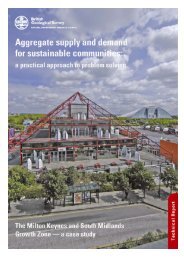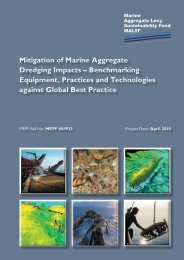creating environmental improvements through biodiversity
creating environmental improvements through biodiversity
creating environmental improvements through biodiversity
Create successful ePaper yourself
Turn your PDF publications into a flip-book with our unique Google optimized e-Paper software.
Sustainable Aggregates Creating Environmental Improvements <strong>through</strong> Biodiversity<br />
Key audiences (MIRO questionnaire):<br />
Mineral planners, farmers, farming and conservation organisations, mineral operators<br />
Key words (MIRO questionnaire):<br />
FWAG, MIRO, Leeds University, Whitwell Quarry, Hope Cement Works, LaFarge<br />
Main methods:<br />
Desktop research on value of minerals extraction sites to nature conservation<br />
Demarcation of land boundaries and ownership around 2 key quarry sites<br />
Phase 2 surveys of operational land within and around the sites<br />
Categorisation of land and suitability for habitat creation / enhancement<br />
Drafting of land management plans and work programmes with landowners and managers<br />
Dissemination of relevant information (e.g. on grants) to farmers bordering the quarries<br />
Work with farmers and landowners (including questionnaire) around quarry sites to gauge awareness of and<br />
interest in local quarrying, and interest in working more closely with quarry operators<br />
Investigation of and advice on financial aspects of land management plans, potential grants, and further<br />
funding to extend the pilot project<br />
Evaluation of pilot project success in terms of land area and habitats affected, improved awareness/knowledge<br />
of LaFarge staff and local landowners, and agri-environment scheme uptake<br />
Output:<br />
Phase 2 habitat survey results for land within and around the quarry sites<br />
Land management plans and work programmes for land around each quarry<br />
Identification of, and management recommendations for important local habitats<br />
Clarification to minerals operators of best management techniques for certain habitats<br />
Advice for landowners and quarry operators on funding<br />
Impacts (Actual):<br />
Increased enthusiasm and conservation knowledge among local minerals operators<br />
Raised awareness among local farmers and landowners<br />
Application to Countryside Stewardship Scheme by one farmer<br />
Funding from quarry operators<br />
The project demonstrates that good relations with minerals operators and local communities can achieve<br />
ecological objectives ‘without the need for additional planning instruments or conditions’<br />
(MIRO questionnaire: success measured by ongoing work around the two quarries selected for the project,<br />
similar engagement with quarry operators, <strong>improvements</strong> in habitat around the site. No gaps in project<br />
identified in questionnaire.)<br />
Impacts (Potential):<br />
Further increase in local awareness <strong>through</strong> word of mouth<br />
Further applications by local farmers to agri-environment schemes<br />
The project provides an example for other schemes that may target agricultural land surrounding quarries<br />
Problems Identified by Study:<br />
Vegetation communities present on extraction sites are often not clearly defined by National Vegetation<br />
Classification – often transitional between ‘open habitats’ and others such as mesotrophic grassland (Rodwell,<br />
2000). This can complicate their management for nature conservation.<br />
Landowner reactions were difficult to gauge due to the change in agri-environment schemes. This should<br />
have settled down more now that ELS and HLS schemes are running.<br />
76

















